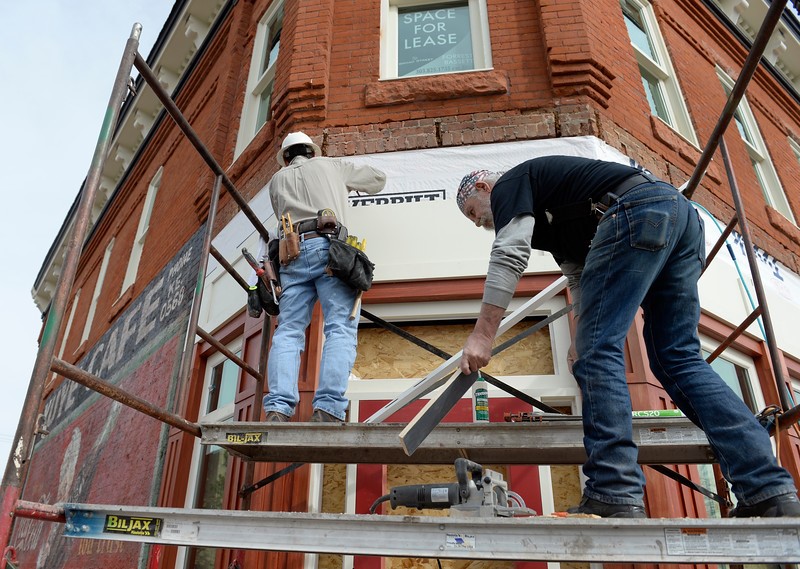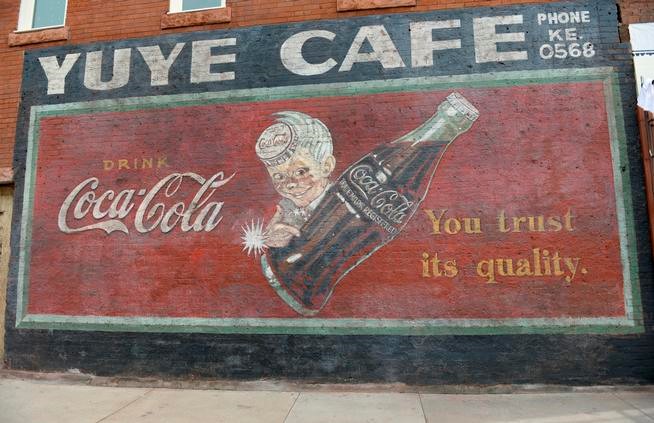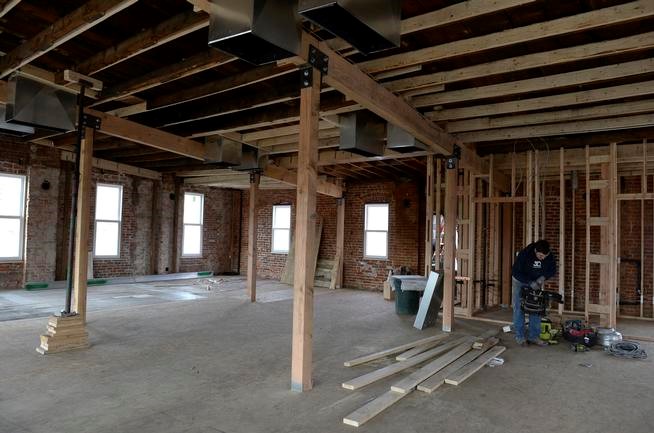Tax credits for historic preservation help spark neighborhood eco-devo
Thirteen buildings across Colorado received the tax credits through a new program to preserve historic commercial buildings

DENVER, CO – MARCH 29: Mitch Seeley, left, and Russell Pope of Spectrum General Contractors, continue work on the exterior of the building. State tax credits are going to companies that are rehabilitating historic buildings around the state, like the former Rice’s Tap House in the historic Five Points neighborhood. This funding is expected to help increase development in surrounding areas. (Photo by Kathryn Scott Osler/The Denver Post)
Workers stripping a layer of stucco from the exterior walls of a late-19th century building on Welton Street, exposed a Coca-Cola advertisement along with the name “Yuye Cafe.”
The ghost sign will remain, preserving mid-20th century nostalgia as 2801 Welton St. in Denver’s Five Points neighborhood is renovated.
Once known as Rice’s Tap Room & Oven, the red brick building in the Welton Street historic corridor is one of 13 structures across Colorado that received income tax credits this year through a new program to preserve historically valuable commercial buildings.
“The goal of the new tax credit was to not only restore and preserve historic commercial buildings in Colorado, but also to provide an opportunity to stimulate economies across the state,” state historic preservation officer Steve Turner said.
In Five Points, once known as the “Harlem of the West,” the Welton Street Corridor is undergoing a rebirth.
“The Welton Corridor is an evolving corridor. What we see today and what we will see in five years, is significant change,” said Bob Cardwell, a partner in Star Mesa properties, which is renovating the building at 28th and Welton streets.
The building was a touchstone in the Five Points jazz scene when it housed the Tap Room, a jazz club.
Star Mesa received preliminary approval for a $165,000 historic building tax credit, to help with the $1 million renovation, Cardwell said. The renovated building will hold a restaurant and office space.
________________________________________
________________________________________
The tax credits, which will be awarded each fiscal year, offer a dollar-for-dollar reduction in the amount of tax owed to the government.
To qualify, a building has to be an income-producing property, and must be designated as a local, state or national historic landmark or be located in a historic district, History Colorado’s architectural services manager Joe Saldibar said.
The credit replaces an earlier historic preservation credit that was capped at $50,000. This meant massive preservation projects, like the $54 million restoration of Denver Union Station, got little in the way of preservation tax credits, Saldibar said.
The new, transferable state income tax credits are part of the Job Creation and Main Street Revitalization Act, which became law in 2014.
Final approval comes when the project is complete, and meets state standards for historic preservation.
The Tap Room restoration wouldn’t have been economically feasible without the credit and unrelated tax increment financing, Cardwell said.

As crews removed stucco covering the exterior of a building, they found this Coca-Cola ad, which they worked to preserve. (Kathryn Scott Osler, The Denver Post)
“We had to have those tax credits to make this thing work. Zoning would have allowed us to tear it down and put in a building with a number of stories,” he said. “We were throwing the dice to make something that would have a reasonable return on the investment.”
About 6-miles away, at 2501 Dallas St. in Aurora, work on the 62 year-old Stanley Aviation building, another of the project granted a tax credit, is expected to be complete this summer.
Flightline Ventures began renovating the 140,000-square-foot building in 2015.
Fifty tenants are already lined up for space in the building, which will be called Stanley Marketplace, and it is expected to be full the day it opens, Flightline Ventures partner Mark Shaker said.
Reviving the 22-acre aircraft ejection seat factory campus to include a beer garden, restaurants and other businesses has already sparked interest in the long neglected surrounding neighborhood.
“The interest in that area has gone up about 82 percent over the past year,” said Tim Gonerka, retail specialist for the City of Aurora. “There is a lot of interest from new developers, especially folks who specialize in infill, and from retailers who would never have taken a look at that area before.”
The Stanley property lies just across Westerly Creek from Denver’s booming Stapleton neighborhood.
But the Aurora side of the municipal boundary has long been stagnant, said Nadine Caldwell, a former Aurora City Councilwoman.

The upstairs space in the Welton Street building will be used for office space. State tax credits are going to companies rehabilitating historic buildings. (Kathryn Scott Osler, The Denver Post)
Now “we hear stories of folks walking down the street knocking on doors looking for folks that want to sell their homes,” Aurora city manager George Noe said.
Vacant since 2006, the Stanley campus is located in an “opportunity triangle” that connects Stapleton, the mixed-used Lowry neighborhood and the 578-acre Fitzsimons campus, which includes the Anschutz Medical Campus and the Fitzsimons Innovation Campus.
Eventually, city officials expect young professionals to flock to the Stanley area, much as they have to the Highlands neighborhood in Denver, Gonerka said.
In Greeley, a plan to turn the Greeley Ice House on the east side of downtown, into a historic loft apartment complex, with a new building of affordable housing, qualified for $978,287 in tax credits.
The surrounding neighborhood is an “edgy old agricultural area,” near the city’s historic downtown district, said Pam Bricker, executive director of Greeley’s Downtown Development Authority.
“I still talk to people who remember going there to pick up blocks of ice,” Bricker said of the almost 90-year-old building.
Downtown attractions are within walking distance, and the Ice House abuts the Sunrise neighborhood, a diverse area that flourished in the first half of the 20th century.
“We expect this will increase development,” Bricker said.
In recent years, Greeley has made improvements to the neighborhood, recently installing a metallic arch to welcome residents and visitors.
Also approved for the credits, are the Cannery Lofts and Buddhist Temple, both in Brighton; Cathedral High School, and the Alliance Center, in Denver; the Odd Fellows Building, in Englewood; E.A. Schlitcher House, in Fort Collins; the Home Light and Power Building, in Greeley; the Pearson building in Louisville; Riverside Block in Pueblo; and the Trinidad Opera House in Trinidad.
By Tom McGhee


